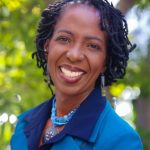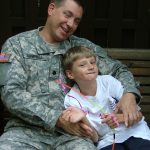Four Parents, Four Takes on Safety
June 04, 2025
By: Crystal Sanford, Kris McElroy, Naina Narayana Chernoff, and Scott Campbell
Categories: Self-Advocates, Safety, Military, Families, Message
Ready or not…here comes summer! It’s almost time for family vacations, dipping our toes in the sand or pool, and savoring late-night sunsets. But for some, summer doesn’t bring excitement and anticipation. Unfortunately, for some parents of autistic children, summer only brings more anxiety and fear of the unknown. Autistic individuals experience a heightened risk for injury and unfortunately death as compared to their same-age peers. Suffocation and drowning appear to be two of the most common fatal injuries.
Why bring up this morbid fact? Because with the lack of structure and increased time potentially unsupervised (or supervised by less familiar people) during the summer, autistic children especially may be more at risk for elopement and injuries. With this in mind, our family developed a safety plan for our then three-year-old autistic daughter so that everyone who cared for her could be empowered to support her safety. My health challenges with cancer that forced me to be away from my children at times was also a big motivator to develop this plan.
When developing a safety plan, my husband and I considered many factors. We wanted the plan to be comprehensive, yet not too overwhelming so that anyone could pick it up, read it, and move forward fairly easily with implementation. We considered her preferences and non-preferences, including:
We knew that if our daughter was able to engage in more preferred activities, she would likely be happier and safer. However, if she was forced to engage in less preferred activities, there was more chance that she may wander or elope which could place her in unsafe situations. We shared our plan with all family members, respite care providers, and anyone who could potentially support our daughter.
Our daughter is now 14 years old. Over the years, we have revised our plan as her interests, strengths, and preferences have ebbed and flowed. We have used the plan during the summer and all year long at some points. Although it was time-intensive to create, having this plan has provided us with peace of mind that we have truly appreciated.
So, dear reader, go out there and have some fun this summer in the small and big moments. But before you do, take some time to develop your own safety plan. You won’t regret it!
 Crystal Sanford, M.Ed., M.A. CCC-SLP, ASDCS, is an author, speaker, and speech-language pathologist. Her most valued role is being the parent of two amazing neurodivergent teen daughters, one of whom is autistic. Through the Sanford Autism Advocacy Group, LLC, she empowers parents and professionals in autism and strength-based individualized education programs.
Crystal Sanford, M.Ed., M.A. CCC-SLP, ASDCS, is an author, speaker, and speech-language pathologist. Her most valued role is being the parent of two amazing neurodivergent teen daughters, one of whom is autistic. Through the Sanford Autism Advocacy Group, LLC, she empowers parents and professionals in autism and strength-based individualized education programs.
Summer is a season of family fun, adventure, and memory-making. However, for families like mine with a neurodivergent child, safety becomes paramount as summer brings bigger playgrounds, outdoor events, and pools—all sources of major excitement. The potential for eloping, accidents, and getting lost can quickly turn joyful outings into frightening nightmares. As we’ve increased awareness and safety planning, we can approach summer with cautious readiness and still enjoy some family fun.
The importance of year-round safety became strikingly clear after one unforgettable incident: my daughter disappeared in the blink of an eye. I had turned away for a mere 20 seconds to shut the door, and she was gone. Panic seized me as I frantically searched the neighborhood, eventually finding her with a neighbor and a dog (she loves dogs). This event, mixed with others, were terrifying, sparking an urgent need for a safety plan.
Our family plan is built on:
While our safety priming and planning haven’t entirely eliminated eloping, they have significantly helped manage it. Creating this plan has been crucial for our peace of mind; knowing we have protective measures in place has made a substantial difference; we can better support her impulsivity, wandering, and eloping. Summer adventures, here we come!
 Kris McElroy is a biracial, Black, autistic, transgender man with multiple disabilities living in Maryland with his wife and daughter. He earned a B.S in Psychology and an M.S in Multidisciplinary Human Services. He is an advocate, writer, and public speaker on trauma, neurodiversity, disability, mental health, and parenting.
Kris McElroy is a biracial, Black, autistic, transgender man with multiple disabilities living in Maryland with his wife and daughter. He earned a B.S in Psychology and an M.S in Multidisciplinary Human Services. He is an advocate, writer, and public speaker on trauma, neurodiversity, disability, mental health, and parenting.
Danger can come in many forms. However, most of the time, what we fear will happen is so different from the actual danger our child faces. Though my autistic son, Dhillon, is now 18, he does not have the capability to keep himself safe.
I always thought that my husband and I had a solid safety plan that involved relying on Dhillon’s ability to communicate and ask for help. We taught him about establishing clear boundaries about his body using visuals and social stories. We coached him in how to call his father or me or who to ask for help if he was ever lost. We set strict communication limits on his iPhone. We taught him how to interact with police officers by visiting our local police station and encouraging him to establish relationships with school resource officers. We also asked the local police to attach information to our address in the 911 system to alert police or firefighters about an autistic individual living on the premises. Last, we made sure we had a way to find Dhillon if he ever eloped or got lost by enrolling him in Project Lifesaver.
Despite all of that, we learned of a major blind spot a couple of years ago when Dhillon was harmed by a peer at a summer camp. We had focused on protecting Dhillon from people in positions of authority who might do him harm but never prepared him to protect himself from aggressive peers. We thought Dhillon would instinctively sense harm, that his size would protect him from bullies, and that he would defend himself physically if necessary. None of those beliefs were true. When he needed it most, he did not know how to ask for help.
That experience provided us and Dhillon’s caregivers, teachers, and therapists with clarity about the work ahead. No one person or device can guarantee his safety. Now our work with Dhillon involves building greater situational awareness and helping him become a better self-advocate. We take him out in the community and navigate different situations, including walking in parking lots, crossing streets, and interacting with the public.
We continue to place as many safeguards as possible for Dhillon and serve as a walking public service announcement for how to support autistic people. Creating relationships with more allies benefits all of our children. We try our best to prepare him to navigate the world, nurture the village of supporters who will help him in the process, and presume competence in Dhillon.
 Naina Narayana Chernoff is the founder and CEO of Inclusive Pathways to Success (IPS), a trade school created specifically to train disabled young adults in the skilled trades with a unique curriculum blending instruction in both hard and soft skills. For over 20 years, Naina has worked and volunteered in a variety of roles in the disability community.
Naina Narayana Chernoff is the founder and CEO of Inclusive Pathways to Success (IPS), a trade school created specifically to train disabled young adults in the skilled trades with a unique curriculum blending instruction in both hard and soft skills. For over 20 years, Naina has worked and volunteered in a variety of roles in the disability community.
I realized long ago that the chance of my autistic son having an interaction with our local law enforcement was very, very high. Compared to everyone else, he is statistically five to seven times more likely to have an encounter. The fact that he does not speak at all or have an easy way to communicate means that when he does need help, it will probably not go well and may end up in unfortunate results.
As such, 20 years ago I did the first 9-1-1 flag sheet for my autistic child and delivered it to our local police station. It can provide crucial dispatch data for first responders that our home is a “location of interest.” I talked to the officer at the front desk, and they put it in a binder with similar 9-1-1 flag sheets at their office. Also, they put a note in the 9-1-1 computer system for our home address that we had a flag sheet for our autistic child in their office and “not to respond to our address with lights and sirens” due to our son’s hearing sensory issues.
Parents of Autistic Children of Northern Virginia has a sample 9-1-1 flag sheet under Safety on its Resources page. These sheets must be updated every few years or when there is a major change to the data. They must include your full name, address, phone numbers, and emergency contact persons. Other information could include:
 Scott Campbell is an autism safety and awareness trainer for families and first responders—law enforcement, firefighters, EMTs and others. He has done over 425 of these training sessions, including a dozen of them in national forums. He was selected as a trainer for the University of Virginia Autism Response Training Program in 2024.
Scott Campbell is an autism safety and awareness trainer for families and first responders—law enforcement, firefighters, EMTs and others. He has done over 425 of these training sessions, including a dozen of them in national forums. He was selected as a trainer for the University of Virginia Autism Response Training Program in 2024.